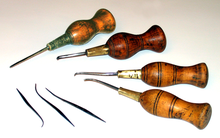awl
A reamer (also known as location , awl or awl referred to) is a simple tool , engraved with the aid of holes in various materials or existing holes may be widened. It is a pointed, thin metal pin that either runs straight or is curved into a sickle shape and can be equipped with a handle or an eye . The awl is often used when working with leather . There are different shapes that are adapted to the specific needs of individual crafts such as shoemaking or saddlery .
The typesetting awl was used in the graphic arts trade for metal typesetting and letterpress printing to correct and bind the finished sentence with a column cord .
In the basket-making trade, this tool is still referred to as the prim , for the ropers it is the splice , in the hardware store it is often referred to as the point drill . Even with the tailors the awl is still used today to z. B. to drill blunt holes in a tissue without destroying the latter.
Saddlers and shoemakers use Plattahlen, Plattört, Flachört, Schwertorten, Sattlerahlen or Selettahlen to prick holes in leather.
In the sailmaker's trade , the awl is called a pricker and often has a plastic handle . It is used to stretch sails, mark straks and prick holes for hand seams.
history

The awl is one of the oldest tools. Even the early Neanderthals were created from bones awls, which were mainly used in the manufacture of fur clothing. The find of a bone plank from Untertürkheim (approx. 120,000 years, Eem warm period ) represents the oldest potential awl. In the late phase of the Neanderthals (between 40-30,000 years, Châtelperronia ), these bone plugs often appear in sites.
Already in the time of the band ceramics , i.e. the first agriculture in Europe, awls were mass-produced from bones. These were almost always made from the pointed metacarpal or metatarsal bones of slaughtered sheep or goats. Even the Copper Age man who lived around 3300 BC. BC on which Similaun died and became known as the glacier mummy Ötzi , carried an awl with him.
Modern awls
In modern tools, the prehistoric awl corresponds to the awl, which consists of a metal spike that is shanked in a wooden handle. There is also the sewing awl, which has a needle eye at the tip and is used for simultaneous piercing and sewing, similar to a strong sewing needle (saddler's needle ). The sewing awl can have a thread spool integrated in the handle.
See also
Web links
Individual evidence
- ↑ Dirk Husemann: The Neanderthal Geniuses of the Ice Age . ISBN 978-3-593-37642-4 , p. 127.
- ^ S. Wenzel: Neanderthal presence and behavior in Central and Northwestern Europe during MIS 5e. In: F. Sirocko, M. Claussen, M. Goñi, T. Litt (Eds.): The Climate of Past Interglacials. In: Developments in Quaternary Sciences , Vol. 7, 2007, Elsevier, pp. 173-193.
- ↑ Diane Scherzler: On the Trail of the Past . SWR.de

